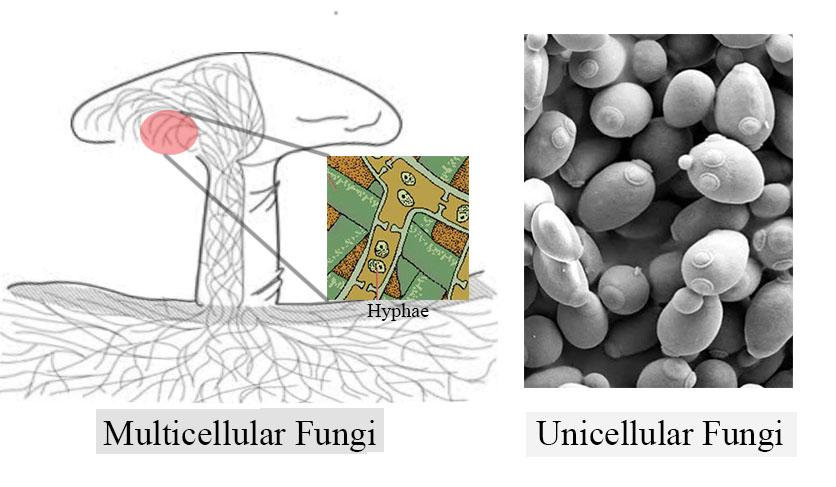
Multicellular organisms and unicellular yeasts are contained in
(a) Animalia
(b) Plantae
(c) Protista
(d) Fungi
(e) Eubacteria
Answer
552.6k+ views
Hint: The kingdom that contains heterotrophic, unicellular, multicellular, parasitic, symbiotic organisms that show a unique feature called dikaryophase.
Complete answer:
Monera, protista, fungi, Plantae, and Animalia are five kingdoms of classification proposed by R.H.Whittaker in 1969. The unique kingdom of heterotrophic organisms is fungi. it contains both unicellular and multicellular organisms. most of them are multicellular. Examples of unicellular fungi are yeast. Puccinia, Albugo are examples of multicellular fungi.
Additional Information:
- Fungi show a great diversity of morphology and habitat. Molds on the bread and orange rots are due to fungi.
- Fungi like mushrooms and toadstools are edible fungi
- The body of fungi consists of a long, slender thread-like structure called hyphae, and the network of these thread-like structures is called mycelium
- Coenocytic hyphae are continuous tubules filled with multinucleated cytoplasm.
- Cell wall is made up of chitin and polysaccharides. Glycogen and oil are stored in food materials.
- Most of the fungi are heterotrophic and saprophytes because they depend on soluble organic matter from dead substrates.
- They also depend on living plants and animals for food. They are called parasites. fungi and algae are in a symbiotic relationship together called lichens and they are also in a symbiotic relationship with higher plants like mycorrhizae.
- In some fungi, two nuclei are present in a single cell called the dikaryotic stage. This phase is called dikaryophase.
So, the correct answer is 'Fungi'
Note: Based on the morphology, mode of spore formation, and fruiting bodies, fungi are divided into various classes namely Phycomycetes (examples: mucor and rhizopus), Ascomycetes (examples: aspergillus and Claviceps), basidiomycetes(examples: Agaricus and Puccinia), and Deuteromycetes(examples: Alternaria and Trichoderma).

Complete answer:
Monera, protista, fungi, Plantae, and Animalia are five kingdoms of classification proposed by R.H.Whittaker in 1969. The unique kingdom of heterotrophic organisms is fungi. it contains both unicellular and multicellular organisms. most of them are multicellular. Examples of unicellular fungi are yeast. Puccinia, Albugo are examples of multicellular fungi.
Additional Information:
- Fungi show a great diversity of morphology and habitat. Molds on the bread and orange rots are due to fungi.
- Fungi like mushrooms and toadstools are edible fungi
- The body of fungi consists of a long, slender thread-like structure called hyphae, and the network of these thread-like structures is called mycelium
- Coenocytic hyphae are continuous tubules filled with multinucleated cytoplasm.
- Cell wall is made up of chitin and polysaccharides. Glycogen and oil are stored in food materials.
- Most of the fungi are heterotrophic and saprophytes because they depend on soluble organic matter from dead substrates.
- They also depend on living plants and animals for food. They are called parasites. fungi and algae are in a symbiotic relationship together called lichens and they are also in a symbiotic relationship with higher plants like mycorrhizae.
- In some fungi, two nuclei are present in a single cell called the dikaryotic stage. This phase is called dikaryophase.
So, the correct answer is 'Fungi'
Note: Based on the morphology, mode of spore formation, and fruiting bodies, fungi are divided into various classes namely Phycomycetes (examples: mucor and rhizopus), Ascomycetes (examples: aspergillus and Claviceps), basidiomycetes(examples: Agaricus and Puccinia), and Deuteromycetes(examples: Alternaria and Trichoderma).

Recently Updated Pages
Master Class 12 Business Studies: Engaging Questions & Answers for Success

Master Class 12 Economics: Engaging Questions & Answers for Success

Master Class 12 English: Engaging Questions & Answers for Success

Master Class 12 Maths: Engaging Questions & Answers for Success

Master Class 12 Social Science: Engaging Questions & Answers for Success

Master Class 12 Chemistry: Engaging Questions & Answers for Success

Trending doubts
What is meant by exothermic and endothermic reactions class 11 chemistry CBSE

Which animal has three hearts class 11 biology CBSE

10 examples of friction in our daily life

One Metric ton is equal to kg A 10000 B 1000 C 100 class 11 physics CBSE

1 Quintal is equal to a 110 kg b 10 kg c 100kg d 1000 class 11 physics CBSE

Difference Between Prokaryotic Cells and Eukaryotic Cells




